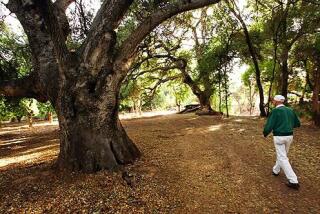Wildlife Tracker Leaves Big Footsteps to Follow
- Share via
JERICHO, Vt. — For more than 20 years, Shakespearean scholar Susan Morse has prowled the wilds of northern Vermont looking for animal signs.
Like the Indians who preceded her, she knows the scratches on the trees and what animal made them--bobcat, bear, deer, fisher, raccoon, otter, coyote and the occasional moose.
Morse is an animal tracker. She has elevated tracking, once the private domain of hunters and trappers, to an art form.
“Walking through the woods with Sue is like walking with a radar dish. She misses nothing,” says Kevin Hansen of Sacramento, who, with Morse’s help, has written a book about cougars. “She is just amazing.”
Morse knows where the bears feed on beechnuts and cherries and which trees are used by mother bears to baby-sit their young. She even has a name for an elderly, celibate fox that lives near her Jericho home: Renard.
There is an area she calls the “bobcat brownstone,” a rock-faced cliff where bobcats have raised litters of kittens.
One thing Morse hasn’t found in Vermont are the tracks of cougars, or mountain lions, catamounts, puma or whatever name one wants to use to describe the big cat.
For that, Morse goes to the Western states and Canada, where her expertise as a cougar tracker has made her famous.
“I’m a regular ‘cat-aholic,’ ” Morse says.
Morse bridges the chasm between wildlife academics and the present-day mountain men, the trappers and hunters who roam the woods looking for the same animals, but for a different purpose.
“I think you have to accept the fact that Sue is rather unique,” says Harley Shaw, a retired wildlife biologist from Arizona who gave Morse a start tracking cougars in the early 1980s. “There is no doubt about it, when she decides to learn about it, she gets it done. Not many trackers have degrees in Shakespearean English.”
Morse has little formal wildlife training. But she has spent countless hours on her own studying academic wildlife literature and in the woods, the “dirt time” needed to learn the meaning of the depressions, scrapes and broken plants that tell her which animal has been there and when.
“She is that unique person with field knowledge and book learning that is so rare to encounter,” Hansen says. “I would hold her up to people with PhDs. I would call her a modern renaissance woman.”
In spite of her love for cougars, Morse stays in Vermont.
“Culturally, I like it here in Vermont,” she says. “There is a healthy attitude toward the land.”
Morse, 47, grew up in Pennsylvania, prowling the woods near Philadelphia. She says her family instilled in her both her love of the outdoors and books.
She studied forestry for two years at Penn State University, but the climate in the 1960s was not conducive to a woman studying the outdoors.
“I wasn’t getting the opportunities in this field,” she says.
In 1969 she transferred to the University of Vermont, where she graduated three years later. She studied English literature because she liked it. Her master’s thesis was on “King Lear.”
Over the years she has worked as a forester, landscaper, stone-wall builder and teacher.
Now, she teaches a course on tracking at Burlington College. She also leads tours of her mountains, one of the most pristine sections of Vermont, a 185-square-mile swath of wild mountain range.
“Ten years ago, you couldn’t sell a course on tracking,” she says. “That interest has exploded in the last five years.”
For the last year, Morse has served as executive director of Keeping Track Inc., a nonprofit organization dedicated to wildlife habitat protection. It’s the first stable employment she has had in years.
Keeping Track also educates the public about the importance of wildlife habitat conservation through field workshops, track and sign survey training, and school and community presentations.
“Today the Vermont landscape has never looked better in the last 100 years,” Morse says. “We could ruin this place in the next 20 years.”
The organization is working with eight towns and has signed on with 10 more. It is also running programs in New Hampshire, New York, California and Arizona.
“We are not doing an inventory of all animals,” Morse says. They are interested in bobcats, bears, fishers, otters and minks.
“The carnivores at the top of the food pyramid have the greatest needs,” she explains.
“We are interested in endangered spaces, not endangered species. We can’t afford to wait. It flies in the face of reason to wait until the crisis of preventing extinction overwhelms you.”
More to Read
Sign up for Essential California
The most important California stories and recommendations in your inbox every morning.
You may occasionally receive promotional content from the Los Angeles Times.












